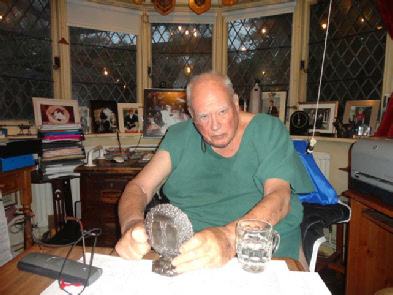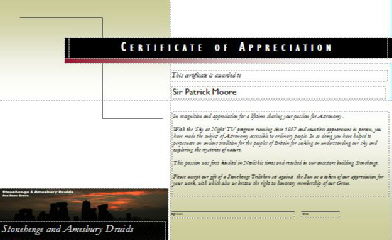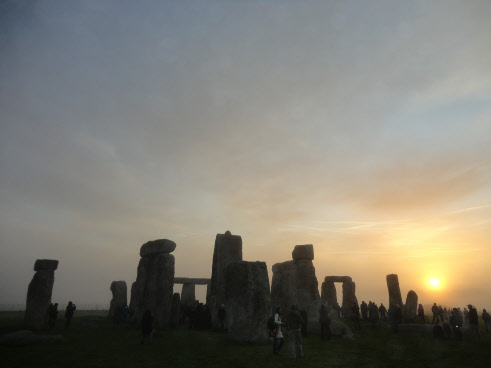
17th October 2011
We salute Sir Patrick Moore

Appreciation
To mark our appreciation for all that he has done for British Astronomy we presented Patrick with a special award featuring a Stonehenge trilithon framed by the sun together with a certificate of appreciation which reads:
“In recognition and appreciation for a lifetime sharing your passion for Astronomy .
With the ‘Sky at Night’ TV program running since 1957 and countless appearances in person, you have made the subject of Astronomy accessible to ordinary people. In so doing you have helped to perpetuate an ancient tradition for the peoples of Britain for seeking an understanding our sky and exploring the mysteries of nature.
This passion was first kindled in Neolithic times and resulted in our ancestors building Stonehenge.
Please accept our gift of a Stonehenge Trilithon set against the Sun as a token of our appreciation for your work, with which also we bestow the right to honorary membership of our Grove.”
He expressed great delight with these.
In true Patrick style he asked about the construction of the award and I told him about how it had been designed and hand made by Amesbury craftswoman Michelle. He then phoned Michelle (Amesbury Forge) personally to thank her for creating such a unique thing for him. Several times during our conversation Patrick expressed how much he liked it.
A British Institution
(Selected excepts referenced from Wikipedia -
Sir Patrick Alfred Caldwell-
He is a former president of the British Astronomical Association, co-
His youth was marked by poor health and as a result he was educated at home by private tutors. He developed an interest in astronomy at the age of six and joined the British Astronomical Association at the age of eleven.
In the Second World War Moore lied about his age in order to join the RAF and from 1940 until 1945 he served as a navigator in RAF Bomber Command, reaching the rank of Flight Lieutenant. He first received his flight training in Canada, during which time he met Albert Einstein and Orville Wright while on leave in New York. The war had a significant influence on his life: his only known romance ended when his fiancée, a nurse, was killed by a bomb which struck her ambulance. Moore subsequently remarked that he never married because "there was no one else for me...second best is no good for me...I would have liked a wife and family, but it was not to be."
After the war, Moore eventually set up home at Selsey on the West Sussex coast, a
location that probably enjoys the highest annual total of clear night skies of any
location in the UK mainland. Here he constructed a home-
Moore was very close to his mother Gertrude, a talented artist who lived with him at his Selsey home, which is still adorned with her paintings of "bogeys" – little friendly aliens – which she regularly produced and which were sent out annually as Moore's Christmas cards. Moore wrote the foreword for Gertrude's 1974 book "Mrs Moore In Space".
On 26 April 1957, at 10:30 pm, in an event that was to be a landmark of his career,
Moore presented the first episode of The Sky at Night, a BBC television programme
for astronomy enthusiasts. Since then, he has presented every episode each month,
excepting July 2004, because of a near-
On 1 April 2007, a 50th anniversary semi-
On 6 May 2007, a special edition of The Sky at Night was broadcast on BBC1, to commemorate the programme's 50th anniversary, with a party in Moore's garden at Selsey, attended by amateur and professional astronomers. It consisted of a retrospective of highlights from the past 654 editions of the programme, together with Moore reminiscing with guests who have appeared over the past 50 years and who have been influenced in various ways by the programme and by Moore himself. Another special edition, broadcast on BBC4 on 9 December 2007, was a retrospective of achievements in astronomical science during the past 50 years, together with a review of the highlights of "The Sky at Night" in presenting such achievements and the contributions of distinguished astronomers to the programme during those years.
In 1959 the Soviet Union used his charts of the limb regions of the Moon to correlate their first pictures of the far side with the features on the near side. In 1965, he was appointed Director of the newly constructed Armagh Planetarium in Northern Ireland, a post he held until 1968. During the Apollo programme, Moore was a presenter of the BBC's television's coverage of the Moon landing missions. He compiled the Caldwell catalogue of astronomical objects and in 1982 asteroid 2602 Moore was named in his honour.
Moore has written over 70 books on astronomy, all of them typed on a Woodstock typewriter of 1908 vintage, which he has always preferred to any more modern device. After the BBC withdrew financial support, he independently produced a 50th anniversary DVD of his life and work entitled The Astronomical Patrick Moore.
Sir Patrick Moore celebrated the record breaking 700th episode of The Sky at Night
at his home in Sussex on 6 March 2011. He presented with the help of special guests
Professor Brian Cox, impressionist and amateur astronomer Jon Culshaw and Lord Rees,
the Astronomer Royal. In the show, Culshaw impersonated Moore and asked the 'real'
Moore questions from viewers, while co-
You can read the full wikipedia article about Patrick at:
http://en.wikipedia.org/wiki/Patrick_Moore


Meeting Patrick
By Stonehenge Druid Frank Somers
I first met Sir Patrick when I was 12 years old. He gave a lecture on Astronomy at my secondary school. I waited to speak with him afterward and presented a barrage of questions to him. At the time I was a bright child, but one who was greatly lacking in self belief and under achieving as a result.
Patrick is one of a very few truly great men who make time for the little people.
He invited me to visit him at his home in Sussex, where he patiently answered my 1001 questions. My first view of Jupiters moons and Saturns rings were through his telescope. It is a great thing, as a youngster to be treated so kindly by one of the best respected scientists in the world.
After that visit I applied myself to my studies and realised my potential by becoming eventually ... a Druid.
Oh well, not the great scientific road for me, but my self respect owes much to the time and patience of Patrick Moore all those years ago.
He has always been most generous with his time and has inspired many young people along the way. I’m sure that some at least have gone on to be scientists, and even those who have not will all share fond memories of this great English Gentleman.
Thirty something years later I have been studying Astronomy again. This time with a view to working out the limits of what would have been possible for our ancient ancestors. What could they learn using only the resources available to them?
I have some theories and ideas of my own for which I needed an experts appraisal. I wrote to Patrick and asked if he would please be willing to help answer all of my questions for a second time.
A few days later I had a call from Patrick who, generous as ever, asked me if I would like to pop round.
Patrick Moore is undoubtedly one of the worlds foremost experts on ‘naked eye’ astronomy so I was very excited to have the possibility of discussing my ideas with him. It was also a possibility to say a personal thank you to him for taking the trouble to answer my questions all those years ago. A pleasure too.
Seated in his study, Patrick listened patiently once more to my questions.
I had one theory in particular which, if correct, or even feasible, would totally vindicate my efforts. If not, I would be ‘back to the drawing board’ and feeling rather silly.
I pulled out my star charts and explained my theory...Patricks response was a solid ‘yes that would work...that’s probably how they did it too!’
I was absolutely relieved and elated. We talked for a while about ancient astronomy and I received many new pointers from Patrick about where to explore next.
We also listened to some of the music written by Patrick. I did not know that he is a musician. He asked me to guess the type of music that he would like. I guessed Bach.
I was wrong. Patrick’s music is very accomplished Marches and Waltzes. A total pleasure to share. There is no doubt in my mind that Patrick is as accomplished a musician as he is an astronomer and communicator.
Patrick remarked to me that he is one of the few men alive to have met the man who first flew an airplane, the man who designed the saturn 5 rocket, and the man who was first to use that rocket to set foot on the moon. I asked about these men, in particular I was interested in what Orville Wright was like.
Apparently he was a quiet and somewhat unhappy man after seeing his invention used for warfare. We shared a regret that it seems every human discovery gets used for war alongside its more beneficial purposes.
We spoke in total for around two hours and I’m not going to share everything contained within our conversation other than to convey to you the remarkable characteristic that Patrick has of talking openly in a way that makes you feel immediately comfortable in his company as if you have known each other for a long time.
We have I suppose, but he most likely treats everyone with the same respect as he has shown to me.
I was reminded of my visit this summer to Bolivia, and how I observed that the Aymara wise people take time to nurture and support the younger generations. Patrick in terms of our culture is a ‘very wise elder’ and he has always made a huge effort to nurture and support others.
People of his ability and stature rarely do this in the west and I can only hope that in the future some of the many people he has inspired will do likewise as they, in turn, become the wise elders.
The Aes Dana Grove of the Stonehenge Druids have a great respect for the ‘astronomer priests’ who left their mark upon our sacred landscape. A love of the sky and of its patterns and cycles was probably a huge inspiration to our ancestors with their deep reverence for nature.
Patrick, through a lifetime of sharing his passion for the sky with ordinary people has made the subject accessible to us all and has kept alive that British passion which started 1000’s of years ago for Astronomy which culminated with the building of Stonehenge.
The Druids were noted to be fascinated by the motions of the heavens.
It is totally fitting that today the modern Druids should choose to honour a great man who’s knowledge and passion for astronomy has made it popular once more, and without who’s enthusiasm and generosity of spirit those of us without a degree in astro physics would have missed out greatly.
We certainly consider it an honour that Patrick accepted our award.
Frank